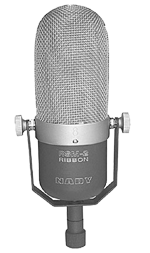 NADY RSM-2
NADY RSM-2
Can a Chinese-made ribbon mic that sells on the street for under 200 bucks hang with ribbons five times its price? Well, almost...
The Nady RSM-2 carries a list price of $249 and looks to be a copy of the AEA R84, right down to the slight difference in sound quality between the front and back sides. It came to me surrounded by two large pieces of foam, and wrapped in a foot-long padded black bag for protection. Inside was the mic, along with a swivel mount and an attached cable.
The RSM-2 features the classic low-tension 2-inch long, 2-micron thick aluminum ribbon design and produces the expected ribbon sound with smooth lows (although nowhere in the literature could I find a frequency response chart). Its specs claim a very high 165dB SPL capability, its pick-up pattern is the classic figure-8, and its proximity effect is quite pronounced.
How does it sound? Out of the box, it does sound like a ribbon mic, but lacks the open high end and presence of the AEA and Blue ribbons. I lent it to my office mate at the university, and he returned it in a day with a note that said “I can’t imagine where I would use this microphone.” In fact, its muffled high end had me wondering if I’d received a defective unit.
A bit of searching on the Internet came up with an explanation. It seems that to reduce returns due to blown ribbons, the Chinese factory added several layers of wind protection to the element, on the inside of the grille. Several posters suggested that removing two metal wind screens and a silk “bag” that enclosed the ribbon element really opened up the high frequency response of the RSM-2.
At that point I stopped; after all, this was a review unit rather than one I owned, although I’m quite sure that if I did remove the extra wind screens I would end up owning it whether I wanted to or not. As it stands I can’t recommend the Nady mic for critical voiceover work, although I am seriously considering buying one for myself and removing the offending internal bits to see if all those postings on the Internet ring true, so to speak. If I do that, I’ll be sure to keep you posted. In any event, it’s an inexpensive ribbon microphone that does sound like a ribbon microphone, and may sound better given a few, shall we say, modifications.
THE WRAP
Both the AEA and the Woodpecker are clear winners. If you’re in the market for a different sound, or if you’re a female VO looking for a microphone with both guts and character, you should definitely check those two ribbons.
Meanwhile, I might just have to get out the screwdriver after all... the Nady mod is calling...
For more information on the AEA, visit www.wesdooley.com; for more on the Woodpecker, visit www.bluemic.com; and for more information on the Nady RSM-2, visit www.nady.com.
SIDEBAR: HOW A RIBBON MIC WORKS
A ribbon microphone is a variation on the dynamic mic in which a thin, corrugated strip of aluminum is suspended between two poles of a strong magnet. When sound waves hit it, the ribbon moves within the magnetic flux field and a small AC voltage is induced in the ribbon proportional to its movement. The clamps attached to either end of the ribbon double as contact terminals, and wires attached to the clamps carry that signal to a step-up transformer, which raises the output voltage and boosts the output impedance to a usable level for a preamp, typically around 150 to 300 ohms.
Because the ribbon element responds to sound waves arriving from both the front and back but not from the sides, most ribbon mics have a natural bidirectional polar pattern (also known as figure-8). They’re often used to eliminate unwanted noise between two sources, or in pairs to form Blumlein stereo pair arrays. Classic ribbon mics have no internal electronics — just the ribbon, magnets, and transformer. As a result, an older ribbon microphone can require up to 60 dB of clean gain from a mic preamplifier, increasing the noise floor of the mic and preamp combination. Modern ribbon designs include some active electronics to reduce the noise floor, and may require phantom power.
Ribbons have a reputation for fragility, because the ribbon element can be stretched and ruined by exposing it to loud sounds or by simply blowing on it (please don’t do that, okay?). Newer materials and construction techniques have greatly reduced this problem, and modern ribbons can be safely used with loud sources. However, it’s still a good idea to treat a ribbon mic more gently than you would a dynamic or condenser mic. In particular, ribbon mics should be covered when not in use to prevent dust-born metallic particles from sticking to the magnet. In addition, ribbon mics should always be stored vertically to prevent gravity from causing the ribbon to sag and stretch in one direction relative to the magnetic gap.
♦
